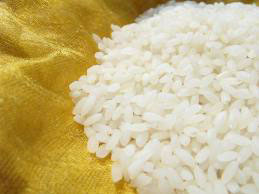

I still make the occasional biryani with Basmati, but it’s become a ‘Plan B’ rice on occasions I can’t source Seeraga Samba. I love how Seeraga Samba retains its texture much like Arborio rice (an essential Italian risotto ingredient) and does not thicken into lumps – al dente comes to mind! It’s less fluffy, too, and absorbs the flavour of the masala instead of lending the dish a strong flavour the way Basmati rice does. Cooking for me is not just about the flavours but also textures. And yet its easier to find Basmati rice in these supermarkets. Thankfully that’s changed, Seeraga Samba is available in quite a few supermarkets in Chennai and Bengaluru. It wasn’t easy to find in Chennai’s supermarkets I sourced this rice from traditional ‘rice merchants’ about a decade ago. One visit to Dindigul was all I need to switch allegiances from basmati to Seeraga Samba.

The rice takes its name from jeera (seeragam in Tamil), while ‘samba’ refers to the season (typically August to January) when it is grown. The rice takes its name from Jeera (Seeragam in Tamil), because the small (much smaller than other rice varieties) ovular grains share an uncanny resemblance to jeera, while Samba refers to the season (typically August to January) when this rice is grown. For many home cooks and chefs this is Tamil Nadu’s version of biryani rice of course, this Samba has no connection with the Brazilian dance moves. Aside from the locally sourced lamb and cooking methods that hadn’t changed much in almost a century, there was one big difference – Seeraga Samba rice.īasmati rice and biryani might be inseparable across India, but ask anyone in Tamil Nadu about their quintessential biryani ingredient and chances are you will hear ‘Seeraga Samba’. After my first meal at Ponram, I realised what the fuss was all about. I’d heard about some fascinating accounts about the flavoursome biryanis that a clutch of ‘Biryani hotels’(yes, people still call restaurants hotels on these parts) were dishing out. For long this town in southern Tamil Nadu was synonymous with locks (just like Aligarh is), but over the last decade or so it’s become the self-proclaimed biryani capital of Tamil Nadu. I still remember my first Dindigul biryani experiences from the aughts. For many in Tamil Nadu, there is no biryani without seeraga samba. Apart from this, all other varieties are also available.Biryani with seeraga samba at the iconic Ponram Restaurant in Dindigul. Buy seeraga samba rice online at futuroorganic. We at f uturoorganic are on our way in bringing back our tradition.

OTHER NAME FOR SEERAGA SAMBA RICE FREE
It reduces free radicals from colon and intestine.It also eases digestion and helps to relieve constipation. Since it is rich in fibre, it controls the calories in the food and thus stops more intake of food.The oil in the seeraga rice reduces cholesterol.This rice variety rice contains components that help prevent cancer.Traditionally used in the preparation of biriyani and preparation of rice items – Lemon rice, Tamarind rice, Tomato rice, etc. The rice is easy to cook, delicious taste and aromatic, rich in vitamins with a high caloric value.This rice absorbs the flavour of masala instead of lending the dish a strong flavour the way basmati rice does. People in South India mostly prepare briyani using this rice. It takes longer duration to grow as compared to other varieties of rice. This rice is grown in samba season (aug to jan).This grain is much harder and eating it gives more filling feel with a high caloric value. Samba rice has a unique taste like starchy or corny flavour. When cooked properly these rice grains are fluffy and loose.It is the most expensive rice grown in that southern India state. This tiny-grain seeraga samba gets its name from its resemblance to cumin, which is seeragam or seera in Tamil Nadu. Samba rice, which is the traditional rice in southern India, comes in many varieties one of which is seeraga samba rice.


 0 kommentar(er)
0 kommentar(er)
